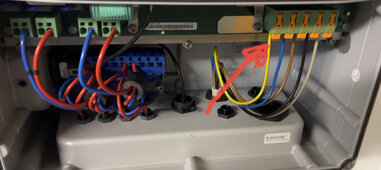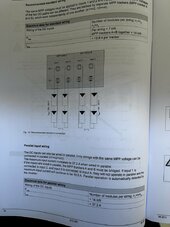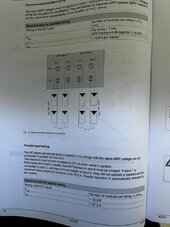wpns
Solar Joules are catch and release
This is a little disconcerting because I don't know what your inverter or wiring is rated for, but most inverters I've seen have a maximum MPPT input voltage of 600V, so if yours is seeing 620V it may refuse to start.Second string’s VOC 620 volt
The reason it might only show the error at mid-day reboots is that as the voltage rises in the morning it'll load the panels down and they won't exceed 600V at the maximum power point input, but if you reboot it mid-day it'll wait a few minutes before connecting the panels, and then the Voc of the string will exceed 600V, and the inverter will throw an error. Why it throws can isolation fault instead of an MPPT input over voltage fault is anyone's guess, but Occam's Razor says it's software bugs. Not that it couldn't be breaking down some over voltage suppressor in the MPPT input, but that's chasing the wrong problem.
Strictly speaking you are correct, your DVM can measure insulation resistance (at one or two volts). It cannot measure insulation resistance at high applied voltages, nor can it measure breakdown voltage, for which you need a different piece of test equipment, as the electrical experts above have mentioned.What ! Are you really sure about that ?
Well there are two ways to measure insulation resistance :
- 1.To short the positive and negative electrodes of the PV string, and measure the insulation resistance between the shorting point and earth.
- 2.Measuring the insulation resistance between the positive electrode and earth and between the negative and earth separately without shorting.
I have a digital clamp multimeter, the only thing is that my meter can’t do a shortcircuit insulation resistance measurement but measuring resistance between + or - to earth is possible
Again: You are making me nervous measuring 620Vdc strings with a meter that _SAYS_ 600V on it, I'm concerned that you aren't taking the proper safety precautions, and that you don't understand how your measurements work or what they mean.
When you say: "let’s suppose i would reboot it now, it will shows" and then post a picture of the wiring, that doesn't give me any confidence. If you are not paying attention, if you are not sure what you are doing, if you don't know what your meter readings are or how they are interpreted, you could die.
That would be bad. Start at the top, and explain it like I'm five. What panels, what strings, what wiring, which inverter, what works and what doesn't, what test equipment do you have available, etc?






